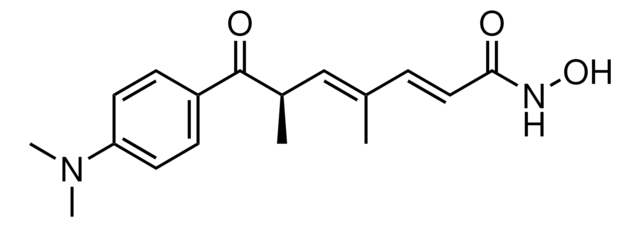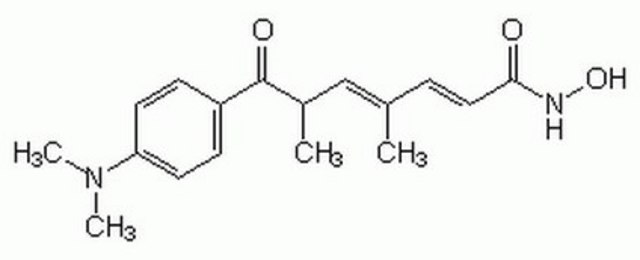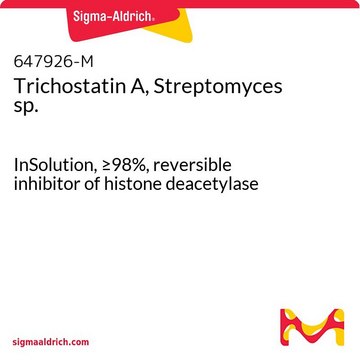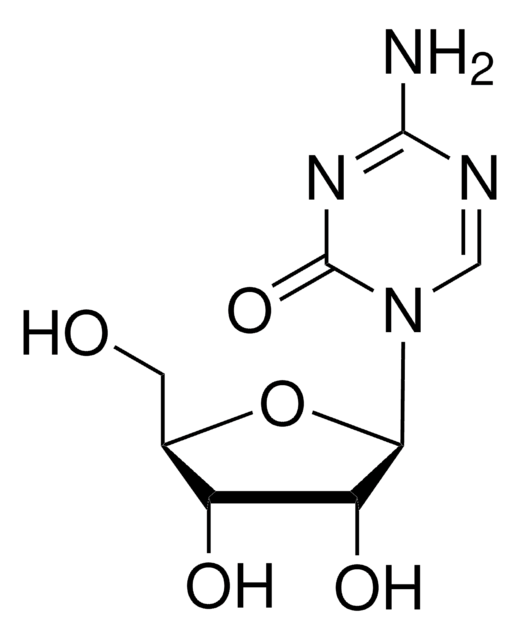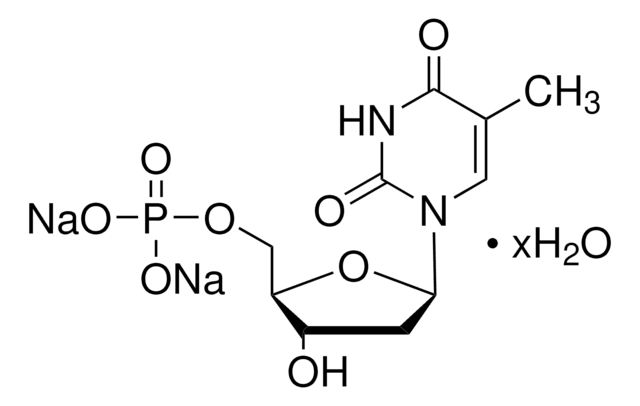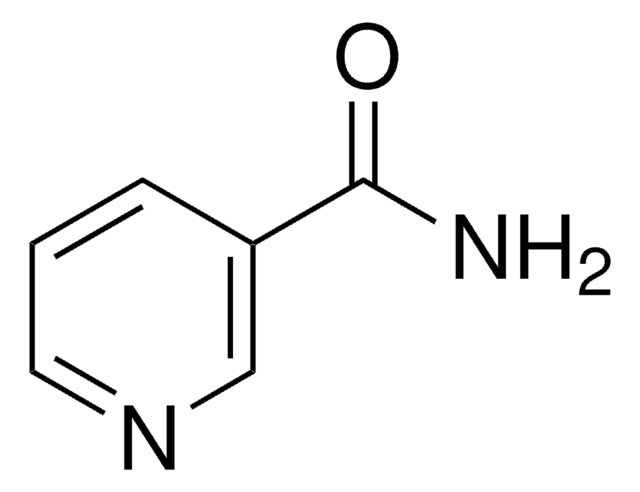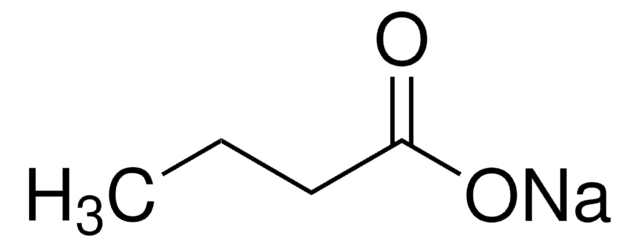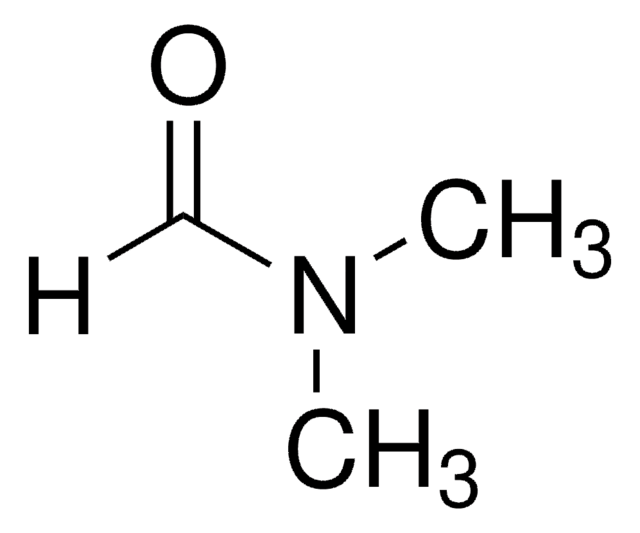推荐产品
生物来源
Streptomyces sp.
质量水平
方案
≥98% (HPLC)
表单
powder
溶解性
methanol: soluble 1.90-2.10 mg/mL, clear, colorless to faint yellow or tan
DMF: soluble
DMSO: soluble
H2O: insoluble
acetone: slightly soluble
acetonitrile: soluble
benzene: slightly soluble
chloroform: slightly soluble
ethanol: soluble
ethyl acetate: slightly soluble
lower alcohols: soluble
储存温度
−20°C
SMILES字符串
C[C@H](\C=C(C)\C=C\C(=O)NO)C(=O)c1ccc(cc1)N(C)C
InChI
1S/C17H22N2O3/c1-12(5-10-16(20)18-22)11-13(2)17(21)14-6-8-15(9-7-14)19(3)4/h5-11,13,22H,1-4H3,(H,18,20)/b10-5+,12-11+/t13-/m1/s1
InChI key
RTKIYFITIVXBLE-QEQCGCAPSA-N
基因信息
human ... HDAC1(3065) , HDAC4(9759) , HDAC6(10013) , HDAC8(55869)
mouse ... ENSMUSG00000061062(15181)
rat ... Hdac7a(84582)
正在寻找类似产品? 访问 产品对比指南
1 of 4
此商品 | 100202 | 110983 | 543897 |
|---|---|---|---|
| technique(s) UV/Vis spectroscopy: suitable | technique(s) GC-HS: suitable | technique(s) gas chromatography (GC): suitable | technique(s) HPLC: suitable |
| Quality Level 100 | Quality Level 100 | Quality Level 100 | Quality Level 100 |
| form liquid | form liquid | form liquid | form liquid |
| UV absorption λ: 270 nm Amax: ≤0.60, λ: 290 nm Amax: ≤0.10, λ: 330 nm Amax: ≤0.01, λ: 275 nm Amax: ≤0.22, λ: 300 nm Amax: ≤0.05 | UV absorption - | UV absorption - | UV absorption - |
| expl. lim. 15.2 % | expl. lim. 15.2 % | expl. lim. 15.2 % | expl. lim. 15.2 % |
一般描述
生化/生理作用
特点和优势
制备说明
相关产品
储存分类代码
11 - Combustible Solids
WGK
WGK 3
个人防护装备
dust mask type N95 (US), Eyeshields, Faceshields, Gloves
法规信息
历史批次信息供参考:
分析证书(COA)
Which document(s) contains shelf-life or expiration date information for a given product?
If available for a given product, the recommended re-test date or the expiration date can be found on the Certificate of Analysis.
How do I get lot-specific information or a Certificate of Analysis?
The lot specific COA document can be found by entering the lot number above under the "Documents" section.
What is the shelf life of Product No. T8552, Trichostatin A?
The product has a recommended retest date (similar to a shelf life date) of 2 years. The actual recommended retest date for each lot is on the Certificate of Analysis located at our website.
How can I solubilize Product T8552, Trichostatin A?
Trichostatin A is soluble in dimethyl sulfoxide (DMSO) and in ethanol, each at 1 mg/mL. It is also soluble in methanol at 2 mg/mL. It is insoluble in water. Additional solubility information can be found on the data sheet on our website.
How should solutions of Trichostatin A, Product T8552, be stored?
Solutions at a concentration of 2 mg/mL in DMSO can be divided into aliquots and stored frozen at -20°C.
Has Product T8552, Trichostatin A been endotoxin tested?
Product T8552 has not been tested for any endotoxin levels, nor has it been cell culture tested.
At what concentration can Product T8552, Trichostatin A, be used as an inhibitor of histone deacetylase?
Trichostatin A inhibits histone deacetylase at nanomolar concentrations. Additional information may be found in the literature references cited on the product detail page for T8552.
How do I find price and availability?
There are several ways to find pricing and availability for our products. Once you log onto our website, you will find the price and availability displayed on the product detail page. You can contact any of our Customer Sales and Service offices to receive a quote. USA customers: 1-800-325-3010 or view local office numbers.
What is the Department of Transportation shipping information for this product?
Transportation information can be found in Section 14 of the product's (M)SDS.To access the shipping information for this material, use the link on the product detail page for the product.
My question is not addressed here, how can I contact Technical Service for assistance?
Ask a Scientist here.
商品
Cancer research has revealed that the classical model of carcinogenesis, a three step process consisting of initiation, promotion, and progression, is not complete.
Apoptosis regulation involves multiple pathways and molecules for cellular homeostasis.
Cell cycle phases (G1, S, G2, M) regulate cell growth, DNA replication, and division in proliferating cells.
We offer a variety of small molecule research tools, such as transcription factor modulators, inhibitors of chromatin modifying enzymes, and agonists/antagonists for target identification and validation in gene regulation research; a selection of these research tools is shown below.
我们的科学家团队拥有各种研究领域经验,包括生命科学、材料科学、化学合成、色谱、分析及许多其他领域.
联系客户支持